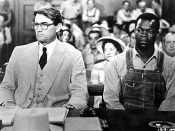Harper Lee wrote To Kill a Mockingbird. Harper Lee tells the story of her childhood in the 1930's in this novel. She makes up fictitious characters to provide the privacy of her hometown and people. In the novel To Kill a Mockingbird Scout is the main character and Harper Lee's fictitious name. The reader watches Scout mature throughout the book in a number of different ways. Scout gains a lot of maturity when she goes to school for her first time, has to help her brother Jem read to Mrs. Dubose, and when she goes through the experience of the trial.
Scout's first major experience in which she grows and matures a lot is when she is just six years old. Scout begins school when she is six years old at kindergarten in the town of Maycomb. Scout's first day of school wasn't very pleasant and she didn't enjoy it at all.
"If I didn't have to stay I'd leave. Jem, that lady says Atticus's been teaching me to read and for him to stop it--" (pg. 18) said Scout. Scout has to learn to deal with her new teacher and her new surroundings. This experience helps her grow tremendously and the reader definitely notices it.
Another maturing experience that Scout goes through is when she and her brother have to read to their neighbor Mrs. Dubose. Jem and Scout's father, Atticus, had accepted to defend Tom Robinson, a black man, in court. The entire family suffered much disapproval from the town for doing so. Atticus told the children to not let anything anyone did or anything anyone said about the trial get to them. However, one day when Scout and Jem were walking home by Mrs. Dubose's house, Jem let it get the best of him.
Mrs. Dubose, an elderly woman, was a neighbor to Jem and Scout. One day when Jem and Scout were walking by, she shouted out many bad remarks to them. One of the remarks was very personal toward Atticus. Mrs. Dubose said, "He's no better than the niggers and trash he works for!" Jem couldn't hold it back any longer and began to destroy her yard, tearing apart her bushes and plants. When Atticus found out, he was extremely disappointed with Jem and made both Jem and Scout read to Mrs. Dubose everyday after school for an entire month. Scout's feelings toward Mrs. Dubose are seen on page 106 when she says, "This was the nearest I had ever been to her, and the thing I wanted most to do was move my chair back again. She was horrible..." The reader sees the maturity process happen to Scout as she goes through this new experience as well.
One last maturing experience that Scout goes through out of her many in the novel is the trial. Living in a town where most people are racist it was hard for Scout when her father accepted to defend a Negro, Tom Robinson. Tom Robinson was convicted of raping a white girl and Atticus was his defendant. Through this experience, friends, relatives, teachers, and neighbors persecute Scout. Scout got in fights often throughout her childhood, but Atticus told her that he didn't want her to get in any more fights if it had to do with the trial. Except for one scuffle at first, Scout didn't fight at all and resisted the temptation. On page 86 after her scuffle, Scout says, "Promise you won't tell Atticus about this. He--he asked me one time not to let anything I heard about him make me mad, and I'd rather him think we were fighting about something else instead. Please promise..." The reader sees the guilt that Scout feels which is a sign of maturation because of her care for her father. From then on, Scout never fights. The reader really sees her grow up and mature a lot throughout the trial.
Throughout it all, we see Scout change and learn a lot. She starts out as a mischievous and curious little girl and ends up as being a lot more mature with many experiences under her belt. She loses her desire to fight, gains respect for others, and gains responsibility for her actions. To Kill a Mockingbird was an excellent example of a novel where the reader easily sees the main character's maturation.



Well written
This is a good book report for junior high. Good job.
2 out of 2 people found this comment useful.